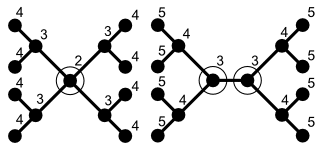
In the mathematical subfield of graph theory, a centered tree is a tree with only one center, and a bicentered tree is a tree with two centers.
Given a graph, the eccentricity of a vertex v is defined as the greatest distance from v to any other vertex. A center of a graph is a vertex with minimal eccentricity. A graph can have an arbitrary number of centers. However, Jordan (1869) has proved that for trees, there are only two possibilities:
- The tree has precisely one center (centered trees).
- The tree has precisely two centers (bicentered trees). In this case, the two centers are adjacent.
A proof of this fact is given, for example, by Harary.
Notes
- (Harary 1969), Theorem 4.2
References
- Jordan, Camille (1869). "Sur les assemblages de lignes". Journal für die reine und angewandte Mathematik (in French). 70 (2): 185–190.
- Harary, Frank (1969). Graph Theory. Addison-Wesley Professional.
External links
This graph theory-related article is a stub. You can help Misplaced Pages by expanding it. |